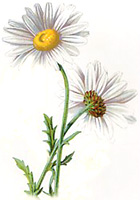
So thank goodness for garlic. Garlic actually wants to be planted in winter. It needs a while in cold conditions in order to start growing. If you're late, you can always stick it in the fridge for a few weeks before you plant, but what gardener would want to pass up on the chance of having something that really, really wants to be sown in January?
January may seem a bit late. The advice on when to sow that you'll find in the gardening books and websites ranges from late October to early spring. But the BBC Gardener's World website says November to January, and that's good enough for me.
I'm sowing in seed trays for now, and will transfer the plants to the containers later on. The Gardener's World website explains how (follow the link above) - or if you speak Italian try a great blog that I've just come across Un pugno di terra e un seme (which translates as A fistful of soil and a seed).
I shall be using the garlic mainly as companion plants to deter pests - harvesting is a lower priority. Garlic supposed to deter just about anything - aphids, red spider mite, colorado beetle, and boring insects (no, not uninteresting ones, but the type that eat into woody stems and branches). You name it and someone will suggest garlic as a remedy. It's also supposed to prevent a variety of diseases - peach leaf curl, apple scab, sooty mold, black spot... All sources however, warn against planting it near peas, beans and other legumes - annoyingly without explaining why. It might possibly be because the antibiotic properties kill off the bacteria which fix the nitrogen produced by legumes in the soil. But I'm hypothesising wildly there. Does anyone know?
Even if you don't want to grow garlic around your plants, you can buy some and use it as a home-made anti-fungal spray. Crush or blend the cloves from three large heads of garlic into about half a litre of water. Leave it to stand and then strain the bits out (or they'll clog up the tube of your spray). Breaking up the tissues of the garlic during the crushing releases a chemical substance called allicin which has antibiotic and anti-fungal properties. I've used it regularly and it seems to work. Not recommended, however, for houseplants. It works all right, but the smell does linger...
Garlic oil is also recommended as a deterrent for slugs and snails. That's one problem you don't get on a balcony, so I can't vouch for whether it works, but it would be worth a try.
As I'm not primarily growing the garlic as a crop, I didn't bother too much about the quality of the cloves, and just stuck in some which I got from the supermarket. If you do this though, make sure that you use organically grown garlic, as otherwise it may have been treated with chemicals expressly to stop it germinating. Another reason for the "lazy" choice is that there's nowhere around here that I can get seed garlic, and my first attempts at sourcing it through the internet only came up with places which either didn't deliver to Europe or only sold it in quantities that were far too large for the balcony.
However, I've now found The Garlic Farm which sells everything you could possibly think of related to garlic, and which has gone firmly onto my list of places to visit the next time I'm on the Isle of Wight. As my last visit was forty-five years ago, a new trip is long overdue. They sell lots of varieties of seed garlic - and will deliver to Europe - and browsing their site has made me think I might just invest in some of the good stuff. Especially as it seems that last year there was a garlic shortage and prices sky-rocketed. Why? Because apparently, a lot of the garlic we eat comes from China, and fears of bird 'flu there meant that domestic supplies were hoarded. No, as far as I know there's no evidence that garlic protects against bird 'flu, but a lot of Chinese seem convinced it does.
I don't know whether the situation will be repeated in 2011 or not, but the thought of the carbon footprint that the garlic I'm using might have clocked up is quite enough to convince me that growing my own might not be a bad idea. And until then, I shall certainly be looking at the labels to make sure that what I buy comes from slightly nearer home - as I said, the stuff that I've planted is organic, and though the packaging doesn't state the origin, it does say that the cultivation methods conformed to the EU regulation 2092/91 which suggests that it comes from slightly nearer home than China, at least.
But if I'm going to grow my own, what varieties will I choose? The Garlic Farm's list had be hopping from one foot to the other like a child in a sweetshop. Should I go for softneck garlic, the type you normally find in the supermarket, which is easy to grow and store - or hardneck garlic, which tastes better? What about trying elephant garlic, with it's huge sweeter tasting cloves? Or should I just go for the Garlic Lover's Seed Selection which will give me nine different varieties and a hundred plants...
A hundred plants. Erm... wasn't that the quantity I didn't reckon I could cope with on the balcony? And aren't even the air miles between the Isle of Wight and Milan a bit exaggerated? It may not be China, but it's hardly local produce.
There are times when trying to live sustainably can be very difficult ...











































